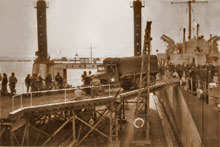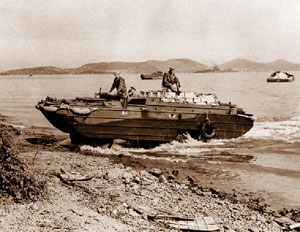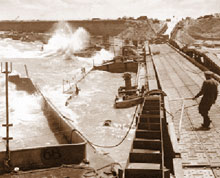Mulberry A and Mulberry B
Mulberry storm

Just before the storm
«25 ton pontoons would remain afloat, though only by an eyelash, under a 38 ton load, but I will guarantee they will remain afloat». It was of course essential that two tanks were never simultaneously over the same span. Ellsberg himself, walking backwards over the half mile to the shore, supervised the passage of the leading tank on June 16 when the center pier was completed and joined to the pierhead.
A second pier and pierhead were ready on June 18.
Eleven LSTs docked and discharged taking about 1 hour per ship, opposed to the 12 or up 14 hours spent waiting for the next high tide. The average time of discharge, states Stanford, was just under two minutes per vehicle. Artillery which would have been difficult to haul over the soft sand was also landed.
The DUKWs job
It must not be overlooked that until the piers and pierheads were completed stores and equipment were being brought ashore by the DUKWs, Rhino ferries and barges. There were about 115 Army crafts, barges lighters, ferries and 100 DUKWs being used in each harbour. The DUKWs especially became virtually indispensable to the success of the operation, operating from D-Day onwards despite the rough weather.

They not only moved «from ship (often three miles out to sea) to shore, as other ferry craft could, but (transported) that cargo overland to a dump». They went far to remedy the shortage of cranes and trucks in the early stages of the assault and «might have been a random piling of supplies on the beach (was converted) to an orderly movement from ship to supply dump». The loads, mainly ammunition and petrol, were carried in three nets, the contents of which were transferred into trucks on shore.
The DUKWs were not, of course, able to handle some of the larger, awkward loads, like bailey bridges sections, included in the cargos. By June 16 the Germans appreciated the significance of the Mulberries, and started to build up air attacks, but facing the very large Allied air supremacy supported by all their anti Aircraft systems, those attacks never succeeded in getting through. To complete these over defended sights, we need to talk about the barrage balloons and the smoke screens laid out by trawlers.
Oyster mine: A real threat
Understanding the suicide mission of attacking the harbours, the Germans put their efforts into minelaying. They concentrated on the harbour entrances, mines being laid anywhere off the beaches were bound to be set off sooner or later, owing to the intensity of the traffic.
In the early hours on June 19 a enemy aircraft began to drop pressure or «Oyster» mines which were detonated by the pressure wave of a ship's hull moving through shallow water. Two of these mines were discovered intact on dry ground and shipped to Portsmouth for examination.
Their use had long been anticipated and although there was no fully effective counter-measure used, in responsea ship's speed was reduced to under 4 knots proved sufficient to reduce the danger.
Discharge of supplies, Vehicle and Troops, from 6 to 19 June 1944
Troops |
Supplies(long tons) |
Behicles |
|
British Beaches(excluding Mulberry B) |
120.729 |
50.400 |
286.586 |
Omaha |
74.563 |
29.242 |
205.762 |
Utah |
49.841 |
14.344 |
126.507 |
The American and British beachheads were now linked up.
Twenty Divisions were ashore with a great numerical superiority on the enemy

The storm
On June 16 and 17 the Channel was too rough for any towing operations. On the evening of the 17th an overdue spell of fine weather appeared likely and Admiral Tennant ordered a maximum effort for the evening of the 18th. Four Phoenixes and twenty-four Whale tows were dispatched to the beachhead, but before they sailed a cold front from Iceland was already spreading rapidly over the British Isles. At the same time a depression from the Mediterranean moved northwards over France. These two disturbances combined to produce a north-north-west wind, later veering to north-east, of force 6-7 during 19-20 June and moderating only slightly on 21-22 June. The wind swept along the north French coast reaching gale force and the sky was overcast with thick low clouds. Eleven of the tows were sunk and one of the Phoenixes ran aground near Omaha beach. At Mulberry A no less determination was displayed than at the Mulberry B. The sailors and the Seabees work days and night against the rough sea, but being so exposed they received the full brunt of the storm. Unfortunately some of the LCTs and other crafts were moored to the piers which increased the waves hold on them. Clark concentrated on trying to save the piers and pierheads. Already exhausted by urging on his men while under fire from shore, he wore himself out and was compelled to return to England, his place being taken by Ard, now specialist of his Bombardons.
Well other 100 lost craft
One of the piers was completely ruined. Its center spans of bridging was bent and twisted in a great arc curving to the west, and its Beetles were either broken loose or beached, or smashed and filled with water. The other pier was not as badly damaged, but was also bent in a great arc. On the night of the 21st the spuds of two pierheads broke and the pontoons were carried ashore. Stanford now concentrated on saving the remaining pierhead. The clutch was released allowing the pontoon to ride freely up and down the spud legs. In this way, it survived, rising and falling with the tide. But it was the destruction of the Phoenixes breakwater that put an end to any chance of saving the harbour. Out of thirty-one units twenty were destroyed; three of them having their backs broken through scour; the others through having their sides burst open by the water pressure within. Several were hit by Bombardons descending on them. Seven blockships broke their backs and others settled deep into the sea bed. Well other 100 crafts were lost and discharge of supplies was brought to a standstill. Vital ammunition supplies had to be flown in and several ammunition ships were beached for unloading. In spite of all this, as soon as the storm abated the DUKWs and ferries began to operate again.